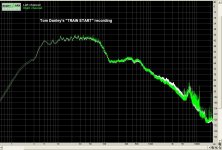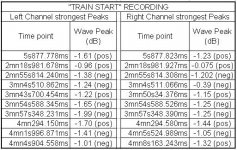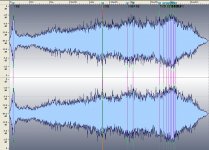I was very surprised that i got a lot of criticism when i brought this concept into the discussion here in 2008. SY presented a lot of "hand waving" or "dancing around" just to avoid any positive control in for example cable tests and afair the "janneman" of that time didn´t know about it too....
Funny? Might be.
Was this (now suddenly so called) routine of calibration really mentionend in the otherwise nice linearaudio article about testing or did i miss the paragraph?
I don't really remember what I said exactly 7 years ago. I don't remember what YOU said 7 years ago. I DO know that I surely had the same view on this as I have now, but you can't always compress a lifetime of experience and views in a few lines of post, but I believe we basically see this the same.
You might have noticed that I usually to talk about 'controlled testing' rather than specifying a specific kind of test protocol.
Jan
Yes, i liked that one too, it's why i included it in my post.
Derp! Must have scanned a bit too quick past that one. Sorry.
se
Althoug it seems to be so simple in fact it isn´t.
Leaving aside all technical considerations, which way do you decide that there is a difference or not?
Is it sufficient that a listener in this simple test tells "can/can´t hear a difference" or are several trials needed?
How many trials should be done and which level of significance should be possible?
Which way do you present the two DUTs, simple A/B, ABX, triangle or some other protocol?
If for example you choose A/B, is it a discrimination (which means only "AB" and "BA" will be presented in a random series) or a same/difference (which means "AB" "AA" "BA" and "BB" will be presented) test?
If you try to do such tests with different listeners you will most probable realize that most of them have difficulities in a controlled test to detect even quite large differences.
It is a difficult task because listeners have to evaluate (and memorize) complex sound events and have to do so reliable/consistent in as many trials that are needed.
Hi Jakob
I am not sure we are on the same page, like I said “To do a “blind test” that passes scientific muster requires a great deal of care and preparation and is why drug testing is done like it is, often “double blind” where even the doctors don’t know what you’re being given.”
On the other hand, outside of emergency warning systems that MUST be intelligible, audio normally isn’t a life and death issue, it’s mostly subjective and experiments with changes in ones system are often done by “non-experts”.
The reason for testing without prior knowledge is that what you know and see plays such a strong role in the subjective impression while having zero impact on the actual vibrations in air reaching your ears.
When you remove “what you know and see” one is forced to make a judgment based only on what your ears tell you, just like a hearing test.
An earlier post I made has several examples of that in video form, give them a try if you havn’t.
Now, usually what matters is if there is any difference? Is the difference I hear between a $500 thing and a $5000 thing worth the extra $4500?
Can I hear these special knobs, magic rocks or cable towers or is it simply knowing that they are there that makes the difference?
None of this closer look aids in the selling part but is a part of this hobby and worse, it may deter people from being curious about the actual mysteries that fill the blank spaces in our knowledge. .
At least with loudspeaker driver development, essentially anything you change may cause an audible difference but then the issue is often one where a given change makes some kinds of music sound better but others worse.
When building for one’s own enjoyment, you can fine tune around your favorite music but if one is building things that other people are going to use then what one wants is the best all around reproduction and especially not a favorable coloration around one type of sound / music.
Here the changes that makes the speaker look more like the theoretically ideal device in a TDS measurement is the direction towards a more faithful device, one which will pass more generations in a loudspeaker generation loss recording.
Best,
Tom
Derp! Must have scanned a bit too quick past that one. Sorry.
se
No problem, it is a good demo of your visual input dominating your ears and it works over and over. The Led Zeppelin one only works (best) the first time and ought to convince anyone about the "what you know" part.
Best,
Tom
No problem, it is a good demo of your visual input dominating your ears and it works over and over. The Led Zeppelin one only works (best) the first time and ought to convince anyone about the "what you know" part.
Yeah, that is the best demonstration of the McGurk Effect I have ever come across. And the "Legi_lature" demo is great because it doesn't rely on any visual input, but like the McGurk Effect, it works even when you know what the "trick" is because it's just hard wired into our brains and something we simply have no control over.
And yeah, the Led Zeppelin is best the first time around. That's actually an old one. I recall that the whole "backward masking" controversy over that song dates back to the '80s if not the '70s so there are quite a few people who are familiar with it.
se
Question one is then “are these two cables, capacitors, parts etc, so close to the same I can’t tell them apart using only my ears? Question two “is one better than the other or just different”?
It's ALWAYS important to define the specific question being asked, otherwise one ends up suggesting inappropriate procedures and unnecessarily complicating simple tests. You grasp that- many others don't.
If I claim that X is audible to some non-zero percent of listeners, my experimental design will be different than if I perceive a difference in X with no controls and want to determine if I'm *really* hearing what I *think* I'm hearing.
If you think about it, how does our brain and hearing system compose a 3d image in our head?
May be by training very deep neural networks
Microsoft, Google beat humans at image recognition - Electronics Eetimes
http://www.mdpi.com/2076-328X/5/1/1/pdf
On the LED indicator the peaks were in the -20 to -10dB range so this was weird and weird they were undetectable as different amps up to that point.
An oscilloscope on the Threshold output showed that around the level where the dynamics were altered, what I saw was instantaneous voltage clipping.
Thank you Tom. You can never overemphasize the issue of brief clipping.
The first is a long parked freight train starting up
https://www.dropbox.com/s/jq5n4gj4mpptjpn/TrainStart.wav?dl=0
This is an excellent and difficult recording. (you buy me a beer if the two mics were spaced 15.3mm apart).
There are many peaks caused by low freq sound of ~66Hz which exceed –2dB and yet, none exceeds 0dB.
Most of these peaks have a time period (duration) of 10ms to 12ms at the level of zero crossing of the waveform and 6ms at the –6dB level.
These peaks then provide a good opportunity to check the response of your meters:
Forget the VU meters.
Peak Program Meters have an attack time of 10ms for 80 percent deflection, so they will read low.
True Peak Meters (with ~0.5s peak hold time) should correctly register them.
Sitting in my car, with the windows rolled up and then slamming the door closed normally, produced a peak of nearly 140dB.
Drive the car at various speeds with the window half up or fully down. Attach a mic close to the ear and record the sound. Notice the intensity of sub-sonic frequencies
More involving test with more scary results: If you drive a motorbike, place the mic btn the ear and the helmet.
I bet a good percent of my tinnitus is due to the motorbike riding.
George
Attachments
Last edited:
@abraxalito
IEEE-754 allots 24 bits to the mantissa of 32 bit floats so you get essentially identical performance to 24 bit ints (theoretical 144dB undithered and 141dB dithered numerical DNR, (perfect noiseless converters). I confirmed this in Python, it turns out Cooledit uses 32bit floats in its FFT and this contaminates things with numerical noise.
Sign bit: 1 bit
Exponent width: 8 bits
Significand precision: 24 bits (23 explicitly stored)
IEEE-754 allots 24 bits to the mantissa of 32 bit floats so you get essentially identical performance to 24 bit ints (theoretical 144dB undithered and 141dB dithered numerical DNR, (perfect noiseless converters). I confirmed this in Python, it turns out Cooledit uses 32bit floats in its FFT and this contaminates things with numerical noise.
Sign bit: 1 bit
Exponent width: 8 bits
Significand precision: 24 bits (23 explicitly stored)
Last edited:
With regard to localisation of sounds - whether it is learnt or comes naturally,  - a key marker for convincing sound is that the auditory cues are reproduced well enough that they override what the analytical brain knows, and the eyes can see. When the "good sound" plopped into my lap some 30 odd years, this is what I found staggering, completely bowled me over - no matter what I did in terms of moving to a particular spot with respect to the speakers, I could not shake off the illusion that the sound was emerging from the spaces that the recording had effectively encoded them to be. This illusion only lasted a short time because of still remaining problems in the playback chain, which caused the perceived location of the sounds to collapse back into the speakers - it returned to "conventional", relatively decent quality audio.
- a key marker for convincing sound is that the auditory cues are reproduced well enough that they override what the analytical brain knows, and the eyes can see. When the "good sound" plopped into my lap some 30 odd years, this is what I found staggering, completely bowled me over - no matter what I did in terms of moving to a particular spot with respect to the speakers, I could not shake off the illusion that the sound was emerging from the spaces that the recording had effectively encoded them to be. This illusion only lasted a short time because of still remaining problems in the playback chain, which caused the perceived location of the sounds to collapse back into the speakers - it returned to "conventional", relatively decent quality audio.
This has always made it trivially easy for me to assess the quality of playback - I merely have to monitor how close the output sound is to achieving that clarity which allows the illusion to form - the "metric" is, how far is the quality from that required to make it happen.
This has always made it trivially easy for me to assess the quality of playback - I merely have to monitor how close the output sound is to achieving that clarity which allows the illusion to form - the "metric" is, how far is the quality from that required to make it happen.
Last edited:
When the "good sound" plopped into my lap some 30 odd years, this is what I found staggering, completely bowled me over - no matter what I did in terms of moving to a particular spot with respect to the speakers, I could not shake off the illusion that the sound was emerging from the spaces that the recording had effectively encoded them to be. .
Burning bush moment aside, you do realise that you can get amazing holographic imaging with incredibly poor FR. Us brits were accused of falling into this trap 30 odd years ago with our mini-monitors. It sounds like you value stereo image over other accuracy. which is fine, so do I, but in my case for different reasons.
If Richard has a clear psychoacoustically controlled demonstration of 24/96 actually scoring better vs 16/44 with competent production in a representative home music playback scenario he should be publishing his own AES papers
Wow I'm glad I missed this stuff it does make one cringe.
The maximum achievable dynamic range for a digital audio system with uniform quantization is calculated as the ratio of the largest sine-wave rms to rms noise.
Dick - Sorry to say the rms noise in a 20-20kHz BW is an AVERAGE measurement. In any case the DNR of a 24 bit number dithered at 1 LSB TPDF is 141dB this is mathematically provable. All
deviations from this are due to noise and non-ideality in the converter/amplifier chain.
Last edited:
This is probably why the "disappearing speakers" trick works so well - it is hard wired: when the auditory cues are sufficiently well reproduced our brains have no choice but to interpret what they hear as being sounds originating from somewhere which is not where the speaker is.Yeah, that is the best demonstration of the McGurk Effect I have ever come across. And the "Legi_lature" demo is great because it doesn't rely on any visual input, but like the McGurk Effect, it works even when you know what the "trick" is because it's just hard wired into our brains and something we simply have no control over.
I agree. FR has almost nothing to do with imaging, and I don't worry in the slightest about FR. The interesting thing is that a member up the road has a full blown DEQX setup which has been dialed in, over and over again, for response as flat as the most obsessive could want - and guess what it sounds like on the recordings I know well - the same!!Burning bush moment aside, you do realise that you can get amazing holographic imaging with incredibly poor FR. Us brits were accused of falling into this trap 30 odd years ago with our mini-monitors. It sounds like you value stereo image over other accuracy. which is fine, so do I, but in my case for different reasons.
What destroys the holographics are distortion artifacts, they kill it stone dead - so my solution is to eliminate those artifacts; I never worry about FR. The big plus of such an approach is that the sound is "convincing": it sounds 'right' a few inches away from the speakers, at any place in the room, from any room in the house, and if you choose to walk around the house on the outside.
Last edited:
Define a "serious audio listener" ... 
Sorry, I listen to audio for enjoyment - as for systems being "technically correct", nearly all I hear have such obvious audible flaws; and that aspect is so intrusive, it's like having a mosquito hovering while trying to concentrate ...
Sorry, I listen to audio for enjoyment - as for systems being "technically correct", nearly all I hear have such obvious audible flaws; and that aspect is so intrusive, it's like having a mosquito hovering while trying to concentrate ...
Tube amp distortion is a whole different order from what I worry about - that's why I use the term "artifact" - tube sound to me typically is too "nice"; everything is covered with maple syrup ...
That depends on the amp, you can make tubes sound just like transistors and vice versa. KT88's are especially good for doing that, just not quite as detailed as good SS.
- Status
- Not open for further replies.
- Home
- Member Areas
- The Lounge
- John Curl's Blowtorch preamplifier part II


